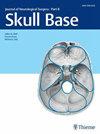内窥镜下颅底前脑膜脑脊液漏修补术:我们的术中、术后方案和长期疗效
IF 0.9
4区 医学
Q3 Medicine
引用次数: 0
摘要
目的:我们评估了一个由神经外科医生和耳鼻喉科医生组成的团队采用特定手术方案进行修复和术后评估的长期疗效。设计:回顾性审查了 2015 - 2023 年期间接受内窥镜鼻内修复脑膜脑瘤(MEC)和脑脊液(CSF)漏患者的病历。分析了修复和重建的术中步骤。分析了患者的术后评估和并发症。研究地点洛约拉大学医学中心的电子病历数据库 参与者:43 名患者(32 名女性),年龄在 11 至 20 岁之间:43名患者(32名女性),年龄在11-81岁之间:采用单一团队和方案对 MEC 和 CSF 漏进行内窥镜鼻内修复的患者的长期疗效。我们假设并发症和需要二次手术的复发率极低。结果:MEC最常见的部位是楔形骨板。腰椎引流管开口压力从10到35 cmH2O不等,34例患者中有18例在术后立即拔除了腰椎引流管。住院时间中位数为 3 天。平均随访时间为 3.8 年。所有患者均未发现复发或二次手术。一名患者的鼻窦感染得到了成功治疗。8名患者被发现有静脉狭窄,并接受了进一步评估。结论这项研究是由一个团队进行的规模最大的长期疗效分析之一。我们对前颅底 MEC 和 CSF 漏进行内窥镜鼻内修复的具体方案是安全有效的。这些患者在修复后应进行颅内压升高评估和治疗。本文章由计算机程序翻译,如有差异,请以英文原文为准。
Endoscopic Endonasal Anterior Skull Base Meningoencephalocele and Cerebrospinal Fluid Leak Repair: Our Intraoperative and Postoperative Protocol and Long-Term Outcomes
Objective:
We evaluated the long-term outcomes from a single neurosurgeon and otolaryngologist team using a specific operative protocol for repair and postoperative evaluation.
Design:
The charts of patients undergoing endoscopic endonasal repair of meningoencephaloceles (MECs) and cerebrospinal fluid (CSF) leaks were retrospectively reviewed from 2015 - 2023. Intraoperative steps of the repair and reconstruction were analyzed. Patients' postoperative assessments and complications were analyzed.
Setting:
Loyola University Medical Center’s electronic medical record database
Participants:
43 patients (32 female) between 11-81 years old.
Main Outcome Measures:
Long-term outcomes of patients that underwent endoscopic endonasal repair of MECs and CSF leaks by a single team and protocol. We hypothesized that there would be minimal complications and no recurrences, requiring secondary operation.
Results:
The most common site for MECs was the cribriform plate. Lumbar drain opening pressures ranged from 10 to 35 cmH2O with 18 out of 34 patients having the lumbar drain removed immediately postoperatively. The median hospital stay was 3 days. The average length of follow up was 3.8 years. No recurrences or secondary operations were noted in all patients. One patient had a sinonasal infection that was successfully treated. 8 patients were noted to have venous stenosis and underwent further evaluation.
Conclusion: This study represents one of the largest long-term analyses of outcomes by a single team. Our specific protocol for the endoscopic endonasal repair of anterior skull base MECs and CSF leaks is safe and effective. These patients should be evaluated and treated for elevated intracranial pressure following the repair.
求助全文
通过发布文献求助,成功后即可免费获取论文全文。
去求助
来源期刊

Journal of Neurological Surgery Part B: Skull Base
CLINICAL NEUROLOGY-SURGERY
CiteScore
2.20
自引率
0.00%
发文量
516
期刊介绍:
The Journal of Neurological Surgery Part B: Skull Base (JNLS B) is a major publication from the world''s leading publisher in neurosurgery. JNLS B currently serves as the official organ of several national and international neurosurgery and skull base societies.
JNLS B is a peer-reviewed journal publishing original research, review articles, and technical notes covering all aspects of neurological surgery. The focus of JNLS B includes microsurgery as well as the latest minimally invasive techniques, such as stereotactic-guided surgery, endoscopy, and endovascular procedures. JNLS B is devoted to the techniques and procedures of skull base surgery.
 求助内容:
求助内容: 应助结果提醒方式:
应助结果提醒方式:


